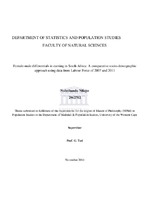| dc.contributor.advisor | Tati, Gabriel | |
| dc.contributor.author | Ntlapo, Noluthando | |
| dc.date.accessioned | 2015-07-28T12:49:56Z | |
| dc.date.available | 2015-07-28T12:49:56Z | |
| dc.date.issued | 2014 | |
| dc.identifier.uri | http://hdl.handle.net/11394/4327 | |
| dc.description | Magister Philosophiae - MPhil | en_US |
| dc.description.abstract | The study examines female-male differentials in earnings and factors associated with them within the labour market of South Africa. Dating back from the end of apartheid in 1994, a few labour policies have been implemented to reduce poverty especially in the area of gender equity and wage discrimination. However, little evidence has been produced to inform on the magnitude of changes in reducing differences and progress achieved so far. Therefore the study attempts to assess and explain the structural changes in female-male differentials in earnings within the labour market. Sparsely conducted studies during the early years of post-apartheid South Africa showed strong racial divide in terms of wage gaps. This proposed study extends this analysis to socio-demographic attributes and also considers a more encompassing notion of earnings. Thus controlling for individual attributes, the overarching issue in this study stems from the following questions: do male workers earn more than their female counterparts within the Labour market? And if it is the case, what are some of the underlying social and demographic variables contributing to this difference? To assess the structural changes in earnings, data utilized for this study are derived from the Labour Force Survey of 2007 and 2011 carried out respectively under Statistics South Africa. Other public records are used to supplement these two sources. In the first step bivariate analysis are carried out to establish patterns and statistical relationships amongst variables selected. Drawing from that, the study makes use of a predictive model to analyse the combined effect of these variables taken together onto the dependent variable. It is expected to observe varying differences in the magnitude of earnings across the selected variables. Differences could be specific to occupation or industrial sector. Temporal variation provides insights about the dynamics of female-male differentials in earnings. From this the study draws some recommendations to guide policy interventions in the labour market. | en_US |
| dc.language.iso | en | en_US |
| dc.publisher | University of the Western Cape | en_US |
| dc.subject | Gender equity | en_US |
| dc.subject | Labour market segmentation | en_US |
| dc.subject | Wage discrimination | en_US |
| dc.title | Female-male differentials in earning in South Africa: a comparative socio-demographic approach using data from Labour Force of 2007 and 2011 | en_US |
| dc.rights.holder | University of the Western Cape | en_US |

